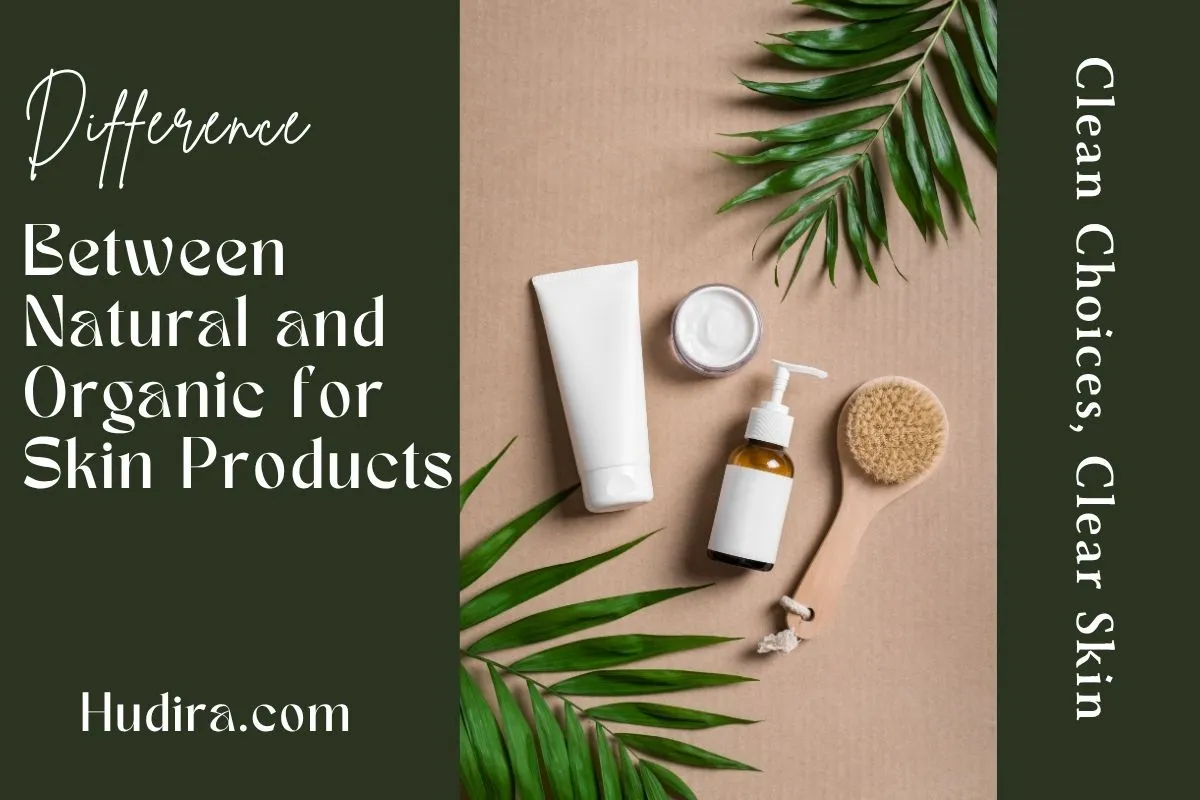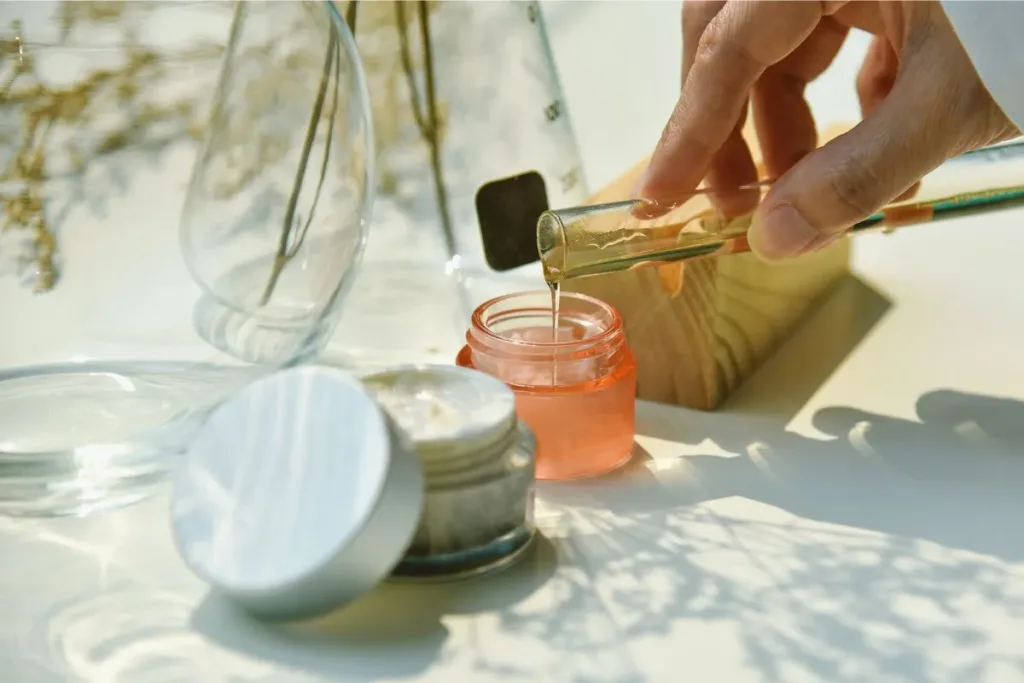No products in the cart.

Quick Read: Confused by product labels? This guide explains the difference between natural and organic skincare in plain language and shows you how to choose safer, more effective formulas for glowing, nourished skin.
Why Do Labels Matter More Than Ever?
Consumers everywhere are rethinking what goes on their skin. As awareness grows around ingredient safety, sustainability, and wellness, searches for difference between natural and organic products have exploded. If you’re trying to build a routine rooted in clean ingredients skincare, you’ve likely met a shelf full of leafy logos, “100% natural” claims, and seals you’ve never seen before. Which ones actually mean something? Which are marketing spin? And how do they affect organic skin health and long‑term results?
Here’s where it gets interesting: the difference between natural and organic is not just about farming. It affects purity, potency, irritation risk, shelf life, and even how your natural skin barrier responds over time. In this guide, we’ll decode the labels, expose common greenwashing tricks, compare standards head‑to‑head, and help you choose wisely — especially if you want skin care natural ingredients that truly respect your values. Ready to find out what’s really in that “all natural vs organic” bottle? Let’s dig in and shop smarter with Hudira at your side.
What Does “Natural” Mean in Skincare?
“Natural” generally indicates that an ingredient began life in natural plant, mineral, or animal derived rather than being fully lab‑synthesized. Sounds straightforward, but there’s no single global legal definition governing when a brand may use “natural.” Many companies label a formula “natural” if it contains some botanically sourced materials, even if the base is synthetic.
Common Characteristics of Products Marketed as Natural
- Contain botanicals, clays, oils, waxes, hydrosols, or extracts.
- May include minimally processed ingredients aligned with skin care natural ingredients ideals.
- Often fragrance‑free or scented with essential oils (though that’s not guaranteed).
- May still contain preservatives, texture agents, or emulsifiers from synthetic sources.
Pros
- Typically marketed as gentle for natural skin support.
- Rich in phytonutrients, antioxidants, and fatty acids.
- Appeals to consumers seeking organic and natural products (even when not certified organic).
Cons
- “Natural” label unregulated = inconsistent standards.
- Essential oils can irritate sensitive natural skin if overused.
- Potential for pesticide residue if raw materials aren’t organic.
Hudira POV: When we say natural, we mean formulas driven by plant‑powered, minimally processed ingredients aligned with our commitment to clean ingredients skincare and transparent sourcing.
What Does “Organic” Mean in Skincare?
“Organic” refers to ingredients grown and processed under certified organic agricultural standards that restrict synthetic pesticides, GMOs, irradiation, and certain chemical inputs. In food, organic is tightly regulated. In cosmetics, the rules vary by country, but reputable seals (USDA Organic, COSMOS Organic, ECOCERT, Soil Association) bring clarity.
Organic Ingredient Tiers (Example: USDA)
- 100% Organic: All ingredients (except water & salt) are certified organic.
- Organic (≥95%): At least 95% certified organic ingredients; remaining must meet criteria.
- Made with Organic Ingredients (≥70%): Can list up to three ingredients as organic in marketing claims.
Why It Matters
Certified organic sourcing reduces exposure to agricultural chemicals and supports biodiversity. Many consumers choose organic for both personal wellness and environmental ethics key values we share at Hudira. Stronger sourcing standards also help maintain organic skin barrier integrity by reducing cumulative irritant load.
Caveats
- Certification costs can be high for small artisan brands.
- Some potent lab‑isolated actives (e.g., peptides) cannot be certified organic yet still benefit natural skin.
Fast Comparison Table: Difference Between Natural and Organic Skin Product
| Criteria | Natural | Organic |
| Source | From nature (plant, mineral, animal) but may be mixed with synthetics | Farmed & processed under certified organic standards |
| Regulation | Light / inconsistent | Defined by certifying bodies (USDA, COSMOS, ECOCERT) |
| Pesticide Controls | Not guaranteed | Required limits / prohibited inputs |
| Label Trust | Varies brand to brand | Audited & documented |
| Allergen Risk | Essential oils may trigger | Often lower pesticide residue; EO still possible |
| Ideal For | Consumers wanting skin care natural ingredients emphasis | Those prioritizing purity, sustainability, benefits of organic skincare |
Memorize this: The core difference between natural and organic products is verified farming + processing standards. Natural = origin story. Organic = audited process.
Regulation, Certification & Trust Marks
Let’s go deeper into the regulatory side where the difference between natural and organic skin products becomes legally meaningful.
Key Certifiers
- USDA Organic (USA) – Highly trusted; food‑grade style oversight applied to cosmetics containing agricultural ingredients. Strong proof for all natural vs organic comparisons.
- COSMOS Organic (EU / Global) – Harmonized European standard; allows % labeling and tracks total natural origin index.
- ECOCERT – Early pioneer; now integrated into COSMOS framework in many regions.
- Soil Association – UK certification with sustainability emphasis.
What They Check
- Ingredient growing practices
- Extraction & processing (solvents, residues)
- Manufacturing cleanliness
- Label accuracy
Ingredient Sourcing & Processing: Farm to Face

Understanding sourcing helps you evaluate the difference between natural and organic beyond buzzwords.
Natural Ingredient Pathway
Botanical grown (any farm) → Harvested → Dried / extracted (may use conventional solvents) → Added to formula. No audit required. This route often defines skin care natural ingredients used by indie brands.
Organic Ingredient Pathway
Certified organic farm → Traceable harvest logs → Approved extraction methods → Segregated transport → Certified facility manufacture. These controls protect organic skin routines from contamination and reinforce the benefits of organic skincare over time.
Processing Glossary
- Cold‑pressed oils
- CO2 extracts
- Hydrosols vs essential oils
- Fermented actives (increasingly popular in clean ingredients skincare)
Hudira Ingredient Note: When formulating products for natural skin balance — like our Hudira Orange Glow Face Mask with turmeric and citrus botanicals we prioritize minimally processed oils for nutrient density.
Performance & Safety: How Formulations Impact Organic Skin Health
Your skin barrier responds to ingredient quality, concentration, and synergy. Here’s how that ties to the difference between natural and organic.
Purity & Irritation
Lower pesticide residue and cleaner extraction in organic materials may reduce cumulative irritation for sensitive natural skin types. That’s a subtle but meaningful edge in clean ingredients skincare routines.
Active Potency
Some studies suggest organically grown botanicals can contain higher antioxidant levels due to stress‑driven phytonutrient production. While research varies, this supports choosing organic inputs in glow‑driven formulas, a plus for organic skin vitality.
Formulation Balance
Not every effective ingredient can be certified organic (e.g., niacinamide, certain ceramides). Smart brands combine verified organic botanicals with safe lab actives to deliver results without compromising a skin care natural ingredients philosophy.
Label Red Flags & Greenwashing Watchlist
Because “natural” is loosely used, look out for:
| Red Flag | Why It Matters | Better Choice |
| “Natural” on front, petrochemical base in INCI | Marketing spin ignores difference between natural and organic | Look for % natural origin + cert seals |
| Vague “botanical blend” | Low actives in formula | Transparent ingredient listing; organic and natural products that show source |
| Strong fragrance / sensitizers | Can irritate natural skin | Fragrance‑free or EO‑balanced formulas |
| No batch traceability | Quality inconsistent | Brands like Hudira that disclose sourcing and manufacturing ethics |
Quick Test: Count how many times the brand proves its claims. Real clean ingredients skincare brands show evidence; others just print leaves on the label.
Building a Routine with Clean Ingredients Skincare (Hudira Picks!)
Here’s how to design a daily ritual that honors the difference between natural and organic while showcasing some Hudira favorites.
Morning
- Gentle Botanical Cleanser – Choose sulfate‑free, plant‑based surfactants that respect natural skin pH.
- Hydrating Mist (Rose / Orange Blossom Water) – Supports organic skin moisture balance; look for hydrosols sourced from certified crops.
- Antioxidant Serum – If fully organic actives aren’t available, pair organic oils with lab‑grade vitamin C. This is a smart, balanced skin care natural ingredients strategy.
- Light Herbal Moisturizer – Emulsions using organic seed oils + humectants.
Evening
- Oil Cleanse or Balm – Cold‑pressed organic oils melt makeup without stripping natural skin lipids.
- Hudira Anti‑Acne Face Mask – Clay + herbal actives; embodies our clean ingredients skincare promise.
- Targeted Treatment Oil – Organic turmeric, neem, or rosehip to feed organic skin repair overnight.
Weekly Glow Ritual
- Hudira Brightening Face Mask to enhance tone.
- Hudira Orange Glow Face Mask for radiance; fuses organic and natural products with antioxidant botanicals.
- Finish with a light serum rich in skin care natural ingredients for barrier support.
Choosing By Skin Concern
Tailor choices so the difference between natural and organic works for you not against you.
Sensitive / Reactive Skin
- Favor fragrance‑free certified organic basics.
- Patch test essential oils.
- The benefits of organic skincare include lower residue load that may calm reactive natural skin barriers.
Acne‑Prone Skin
- Clay + botanicals can help absorb sebum; ensure they’re clean‑sourced.
- Avoid heavy comedogenic waxes in “natural” balms.
- Hudira Anti‑Acne Face Mask = clean ingredients skincare support.
Dull / Uneven Tone
- Look for vitamin C, licorice, turmeric (some not certifiable organic but compatible with organic skin regimens).
- Hudira Brightening Face Mask feeds natural skin glow factors.
Mature / Dry Skin
- Omega‑rich organic oils preserve lipids.
- Humectant + emollient layering = stronger organic skin moisture lock.
Sustainability & Ethics: Beyond the Jar
Ethical sourcing is where conscious consumers differentiate brands.
Why It Matters: Choosing certified organic supports soil health, pollinator safety, and lower chemical runoff are all pillars of the benefits of organic skincare movement.
Hudira Commitments:
- Preference for smallholder organic cooperatives.
- Transparent documentation for key botanicals.
- Low‑waste packaging alignment with clean ingredients skincare ethics.
When evaluating all natural vs organic brand claims, ask: Can you trace the farm? Traceability protects both planet and natural skin trust.
Conclusion
You now understand the real difference between natural and organic skin products: one is a marketing descriptor, the other an audited promise. When you choose brands committed to clean ingredients skincare, transparent sourcing, and skin care natural ingredients, you invest in long‑term organic skin resilience and the radiant confidence that comes from caring for your natural skin with intention.
Ready to upgrade your routine? Explore Hudira’s herbal, halal, clean beauty essentials thoughtfully crafted with botanicals chosen for purity, potency, and planet care.
Thank you for trusting Hudira to help you choose better beauty. Let’s glow naturally, organically, authentically.
FAQs
Q. What is the difference between organic and natural skin products?
The difference between natural and organic comes down to proof. Natural means the ingredient started in nature but may be processed or mixed with synthetics. Organic means ingredients were grown and handled under certified standards that restrict pesticides, GMOs, and harsh chemicals. Because certification is verified, organic claims are more trustworthy when choosing organic and natural products for long‑term organic skin health.
Q. What are clean ingredients?
In skincare, clean ingredients skincare refers to formulas that avoid controversial toxins, prioritize transparency, and often include high levels of skin care, natural ingredients and safe lab actives. Clean doesn’t always mean organic, but clean brands often highlight the difference between natural and organic sourcing for clarity.
Q. Are all natural vs organic products always safer?
Not automatically. Poison ivy is natural! Some “natural” essential oils irritate natural skin. Certified organic reduces certain risks, but patch testing is still smart. Combine label reading with brand trust Hudira discloses sourcing so you can enjoy the benefits of organic skincare confidently.
Q. How do I choose products for sensitive or reactive skin?
Look for fragrance‑free, minimal‑ingredient formulas with organic certification where possible. Start with basics that contain skin care natural ingredients like aloe, oatmeal, or chamomile. Gradually layer targeted actives. This protects organic skin barrier function and supports calm, resilient natural skin.
Q. Can I mix organic and conventional products in my routine?
Yes. Many routines blend organic and natural products with science‑backed lab ingredients (like niacinamide or peptides) to achieve results. Focus on high‑impact leave‑on steps (serums, oils, moisturizers) when investing in organic. Use cleansers or masks to reinforce your clean ingredients skincare values without breaking the budget.



Add comment